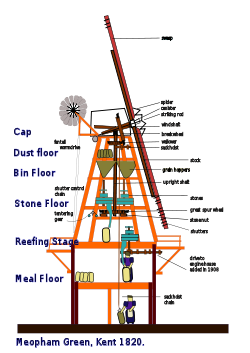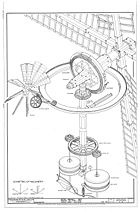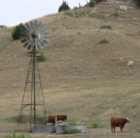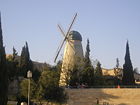Windmill

A windmill is a machine that is powered by the energy of the wind. It is designed to convert the energy of the wind into more useful forms using rotating blades or sails. The term also refers to the structure it is commonly built on. In much of Europe, windmills served originally to grind grain, though later applications included pumping water and, more recently, generation of electricity. Recent electricity-generating versions are referred to as wind turbines.
Contents |
History
Vertical axle windmills
The first practical windmills were the vertical axle windmills invented in eastern Persia by the Persian geographer Estakhri in the ninth century.[1][2] The authenticity of an earlier anecdote of a windmill involving the second caliph Umar (AD 634–644) is questioned on the grounds of being a 10th-century amendment.[3] Made of six to twelve sails covered in reed matting or cloth material, these windmills were used to grind corn or draw up water, and quite different from the European versions. A similar type of vertical shaft windmill with rectangle blades, used for irrigation, can also be found in 13th-century China (during the Jurchen Jin Dynasty in the north), introduced by the travels of Yelü Chucai to Turkestan in 1219.[4]
Horizontal axle windmills
Fixed windmills

Fixed windmills, oriented to the prevailing wind were, for example, extensively used in the Cyclades islands of Greece. The economies of power and transport allowed the use of these 'offshore' mills for grinding grain transported from the mainland and flour returned. A 1/10th share of the flour was paid to the miller in return for his service. This type would mount triangular sails when in operation.
Windmills that turn to face the wind

In northwestern Europe, the horizontal-shaft or vertical windmill (so called due to the dimension of the movement of its blades) dates from the last quarter of the 12th century in the triangle of northern France, eastern England and Flanders. Joseph Needham states that the earliest known reference came in 1191 by a Dean Herbert of East Anglia, who supposedly competed with the mills of the abbey of Bury St Edmunds.[5] These earliest mills were used to grind cereals. The evidence at present is that the earliest type was the post mill, so named because of the large upright post on which the mill's main structure (the "body" or "buck") is balanced. By mounting the body this way, the mill is able to rotate to face the (variable) wind direction; an essential requirement for windmills to operate economically in North-Western Europe, where wind directions are various. By the end of the thirteenth century the masonry tower mill, on which only the timber cap rotated rather than the whole body of the mill, had been introduced. In the Netherlands these stone towerlike mills are called "round or eight-sided stone stage mills, ground-sailers (windmills with long blades/sails reaching almost down to the ground), mound mills, etc." (Dutch: ronde/achtkante stenen stelling molens, grond-zeilers, beltmolens, etc.). Dutch tower mills ("torenmolens") are always cylindrical (such as atop castle or city wall towers). Because only the cap of the tower mill needed to be turned the main structure could be made much taller, allowing the blades to be made longer, which enabled them to provide useful work even in low winds.
-
-
- Post mills in Germany are Bockwindmühlen, Paltrockmühlen or Wippmühlen.
- Smock mills in Germany can be Sockelgeschoßholländers or Galerieholländers.
- Tower mills in Germany can be Turmholländers, Galerieholländers, Erdholländers or Bergholländers
-
Windmills were often built atop castle towers or city walls, and were a unique part of a number of fortifications in New France, such as at Fort Senneville.

The familiar lattice style of windmill sails (also called "common" sails) allowed the miller to attach sailcloths to the sails (while applying a brake). Trimming the sails allowed the windmill to turn at near the optimal speed in a large range of wind velocities. The fantail, a small windmill mounted at right angles to the main sails which automatically turns the heavy cap and main sails into the wind, was invented by Edmund Lee in 1745, in England. The smock mill is a later variation of the tower mill, constructed of timber and originally developed in the sixteenth century for land drainage. With some subsequent development mills became versatile in windy regions for all kind of industry, most notably grain grinding mills, sawmills (late 16th century), threshing, and, by applying scoop wheels, Archimedes' screws, and piston pumps, pumping water either for land drainage or for water supply. In 1772, Scottish millwright, Andrew Meikle developed the spring sail made from a series of connected parallel shutters that could be opened or closed according to windspeed. To do this the sails had to be stopped, but the sails also incorporated a spring which allowed the shutters to open a little more to prevent damage if the wind suddenly strengthens. In 1789, Stephen Hooper invented the roller reefing sail, which allowed automatic adjustment of the sail whilst in motion. In 1807, William Cubitt a Norfolk engineer, invented a new type of sail, known there on as patent sails, using a chain and a rod that passed through the centre of the windshaft. These sails had the shutters of Meikle's spring sails and the automatic adjustment of Hooper's roller reefing sails. This became the basis of self-regulating sails. These avoided the constant supervision that had been required up till then.
With the industrial revolution, the importance of windmills as primary industrial energy source was replaced by steam and internal combustion engines. Polder mills were replaced by steam, or diesel engines. The industrial revolution and increased use of Steam and later Diesel power however had a lesser effect on the Mills of the Norfolk Broads in the United Kingdom, these being so isolated (on extensive uninhabitable marshland), therefore some of these mills continued use as drainage pumps till as late as 1959. More recently historic windmills have been preserved for their historic value, in some cases as static exhibits when the antique machinery is too fragile to put in motion, and in other cases as fully working mills.
See Flood control in the Netherlands for use of windmills in land reclamation in the Netherlands.
In Canada and the United States

Windmills feature uniquely in the history of New France, particularly in Canada, where they were used as strong points in fortifications.[6] Prior to the 1690 Battle of Québec, the strong point of the city's landward defenses was a windmill called Mont-Carmel, where a three-gun battery was in place.[6] At Fort Senneville, a large stone windmill was built on a hill by late 1686, doubling as a watch tower.[7] This windmill was like no other in New France, with thick walls, square loopholes for muskets, with machicolation at the top for pouring lethally hot liquids and rocks onto attackers.[7] This helped make it the "most substantial castle-like fort" near Montreal.[8]
In the United States, the development of the water-pumping windmill was the major factor in allowing the farming and ranching of vast areas of North America, which were otherwise devoid of readily accessible water. They contributed to the expansion of rail transport systems throughout the world, by pumping water from wells to supply the needs of the steam locomotives of those early times. Two prominent brands were the Eclipse Windmill developed in 1867 (which was later bought by Fairbanks-Morse) and the Aermotor, which first appeared in 1888 and is still in production. The effectiveness of the Aermotor's automatic governor, which prevents it from flying apart in a windstorm, led to its popularity over other models. Currently, the Aermotor windmill company is the only remaining water windmill manufacturer in the United States. They continue to be used in areas of the world where a connection to electric power lines is not a realistic option.[9]
The multi-bladed wind turbine atop a lattice tower made of wood or steel was, for many years, a fixture of the landscape throughout rural America. These mills, made by a variety of manufacturers, featured a large number of blades so that they would turn slowly with considerable torque in low winds and be self regulating in high winds. A tower-top gearbox and crankshaft converted the rotary motion into reciprocating strokes carried downward through a rod to the pump cylinder below.
Windmills and related equipment are still manufactured and installed today on farms and ranches, usually in remote parts of the western United States where electric power is not readily available. The arrival of electricity in rural areas, brought by the Rural Electrification Administration (REA) in the 1930s through 1950s, contributed to the decline in the use of windmills in the US. Today, the increases in energy prices and the expense of replacing electric pumps has led to an increase in the repair, restoration and installation of new windmills.
Modern windmills
The most modern generations of windmills are more properly called wind turbines, or wind generators, and are primarily used to generate electricity. Modern windmills are designed to convert the energy of the wind into electricity. The largest wind turbines can generate up to 6MW of power (for comparison a modern fossil fuel power plant generates between 500 and 1,300MW).
With increasing environmental concern, and approaching limits to fossil fuel consumption, wind power has regained interest as a renewable energy source. It is increasingly becoming more useful and sufficient in providing energy for many areas of the world.
One area where turbines have become feasible is in the Midwestern United States, due to great amounts of wind.
Windpumps
A windpump is a type of windmill used for pumping water from a well or draining land.
Windpumps are used extensively in Southern Africa and Australia and on farms and ranches in the central plains of the United States. In South Africa and Namibia thousands of windpumps are still operating. These are mostly used to provide water for human use as well as drinking water for large sheep stocks.
Kenya has also benefited from the African development of windpump technologies. At the end of the 1970s, the UK NGO Intermediate Technology Development Group provided engineering support to the Kenyan company Bobs Harries Engineering Ltd for the development of the Kijito windpumps. Bobs Harries Engineering Ltd is still manufacturing the Kijito windpumps, and more than 300 Kijito windpumps are operating in the whole of East Africa.
The Netherlands is well known for its windmills. Most of these iconic structures situated along the edge of polders are actually windpumps, designed to drain the land. These are particularly important as much of the country lies below sea level.
Primitive eight to ten-bladed windmills were used in the Region of Murcia, Spain to raise water for irrigation purposes.[10] The drive from the windmill's rotor was led down through the tower and back out through the wall to turn a large wheel known as a noria. The noria supported a bucket chain which dangled down into the well. The buckets were traditionally made of wood or clay. These windmills were still in use until the 1950s, and many of the towers are still standing.
Many windpumps were built in The Broads, of East Anglia in the United Kingdom for the draining of land. They have since been mostly replaced by electric power, many of these windpumps still remain, mainly in a derelict state (pictured), however some have been restored.

On US farms, particularly in the Midwest, windpumps were used to pump water from farm wells for cattle. The self-regulating farm wind pump was invented by Daniel Halliday in 1854. Eventually steel blades and steel towers replaced wooden construction, and at their peak in 1930, an estimated 600,000 units were in use, with capacity equivalent to 150 megawatts.[11] Early wind pumps directly operated the pump shaft from a crank attached to the rotor of the windmill; the installation of back gearing between wind rotor and pump crank allowed the pump to function at lower wind speeds. Today water is primarily raised by electric pumps, and only a few windpumps survive as unused relics of an environmentally sustainable technology. This type of windpump can be found worldwide and is still manufactured in the United States, Argentina, and South Africa. A six-foot diameter windpump rotor can lift up to 180 gallons per hour of water with a 15 to 20 mile per hour wind, according to a modern manufacturer (about 700 litres/hour by a 1.8 metre rotor in 24-32 km/hour wind). Wind pumps require little maintenance, only requiring gear oil changes about once per year.[12] An estimated 60,000 wind pumps are stil in use in the United States. They are particularly economical in remote sites distant from electric power distribution.
Tjasker
A tjasker is a type of drainage windmill found in the Netherlands. It is a simple design used for raising water where only a low head is required.
A tjasker comprises four common sails mounted on a windshaft. The windshaft sits on a tripod which allows it to pivot, and carries an Archimedes screw at its lower end. The screw raises water into a collecting ring, where it is drawn off into a ditch at a higher level, thus draining the land. The tjasker can only raise water to a relatively low height.[13]
- See also: :nl:Tjasker
Windmills in culture and literature

- Books
Miguel de Cervantes's book Don Quixote de La Mancha, which helped cement the modern Spanish language and is regarded as one of the greatest works of fiction ever published[14], features an iconic scene in which Don Quixote attacks windmills that he believes to be ferocious giants. This gave international fame to La Mancha and its windmills, and is the origin of the phrase "tilting at windmills", to describe an act of futility.
The Windmill also plays an important role in Animal Farm, a book by George Orwell. In the book, an allegory of the Russian Revolution and the subsequent early Soviet Union, the effort invested to construct a windmill is provided by the animals in the hope of reduced manual labour and increased living standards.
- People
George Green, a famous UK self-taught mathematician and physicist, owned and operated a windmill. Green's Windmill has been restored as cultural heritage.Sir Bernard Montgomery lived in a converted windmill after he retired.
- Films
- 1937 - Oh, Mr Porter! was partly filmed at Terling windmill in Essex.
- 1968 - Chitty Chitty Bang Bang features Cobstone Windmill in Buckinghamshire.
- 1974 - The Black Windmill was partly filmed at Clayton Windmills in Sussex.
- 2001 - Moulin Rouge! is set in the famous Paris caberet nightclub of the same name famous for its iconic red windmill mounted on the roof
See also
- Don Quixote
- Éolienne Bollée
- Klopotec
- Land reclamation
- List of windmills
- Mill machinery
- Molinology
- Renewable energy
- Savonius wind turbine
- The International Molinological Society
- Tension leg platform
- Watermill
- Wind generator
- Wind turbine
Notes
- ↑ دانره المعارف بزرگ اسلامی - اصطخري، ابواسحاق
- ↑ Ahmad Y Hassan, Donald Routledge Hill (1986). Islamic Technology: An illustrated history, p. 54. Cambridge University Press. ISBN 0-521-42239-6.
- ↑ Dietrich Lohrmann, "Von der östlichen zur westlichen Windmühle", Archiv für Kulturgeschichte, Vol. 77, Issue 1 (1995), pp.1-30 (8)
- ↑ Needham, Volume 4, Part 2, 560.
- ↑ Needham, Volume 4, Part 2, 555.
- ↑ 6.0 6.1 Chartrand, French Fortresses in North America 1535–1763: Québec, Montréal, Louisbourg and New Orleans
- ↑ 7.0 7.1 Chartrand, p 41
- ↑ Chartrand, p. 38
- ↑ Quirky old-style contraptions make water from wind on the mesas of West Texas
- ↑ http://www.yachtmollymawk.com/2008/11/spanish-water-works/ Water-lifting mills in the Region of Murcia, Spain
- ↑ Paul Gipe, Wind Energy Comes of Age, John Wiley and Sons, 1995 ISBN 0-471-10924-X, pages 123-127
- ↑ http://www.aermotorwindmill.com/Sales/CommonQuestions.asp Aermotor Web site frequently asked questions, retrieved Sept. 17, 2008
- ↑ "The types of windmills". Odur. Retrieved on 2008-05-24.
- ↑ "BBC - Don Quixote gets authors' votes (Tuesday, 7 May, 2002, 12:03 GMT 13:03 UK)".
References
- A.G. Drachmann: "Heron's Windmill," Centaurus, 7 (1961), pp. 145-151
Further reading
- Ahmad Y Hassan, Donald Routledge Hill (1986). Islamic Technology: An illustrated history. Cambridge University Press. ISBN 0-521-42239-6.
- Chartrand, French Fortresses in North America 1535–1763: Québec, Montréal, Louisbourg and New Orleans.
- Dietrich Lohrmann, "Von der östlichen zur westlichen Windmühle", Archiv für Kulturgeschichte, Vol. 77, Issue 1 (1995)
- A.G. Drachmann, "Heron's Windmill", Centaurus, 7 (1961).
- Needham, Joseph (1986). Science and Civilization in China: Volume 4, Physics and Physical Technology, Part 2, Mechanical Engineering. Taipei: Caves Books Ltd.
- Hugh Pembroke Vowles: "An Enquiry into Origins of the Windmill", Journal of the Newcomen Society, Vol. 11 (1930-31)
External links
- Architecture: Windmills at the Open Directory Project
- Earth Science Australia, Wind Power and Windmills
- The International Molinological Society
- Windmills at Windmill World
- The Mill Database, Europe
|
|||||||||||||||||||||||||
